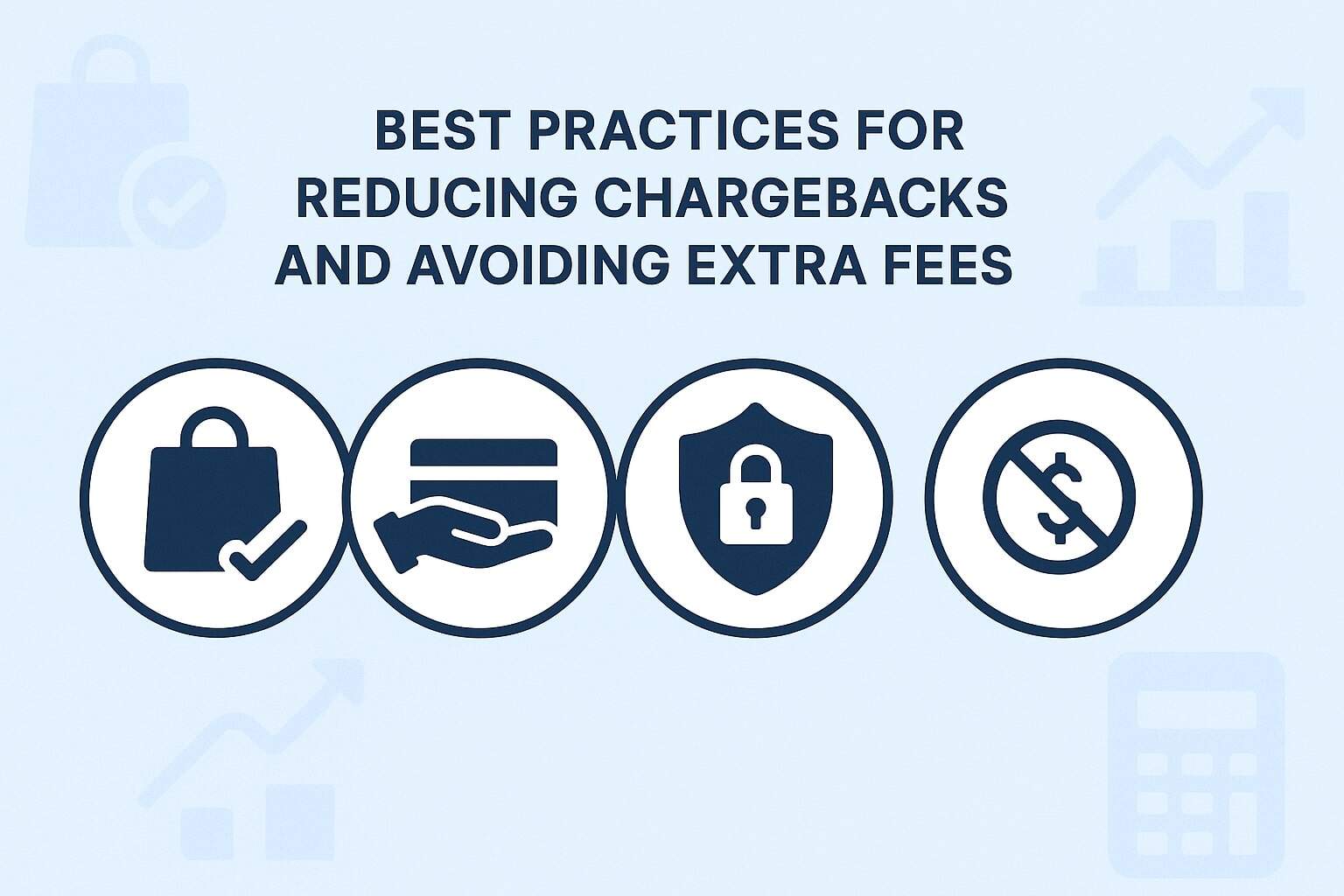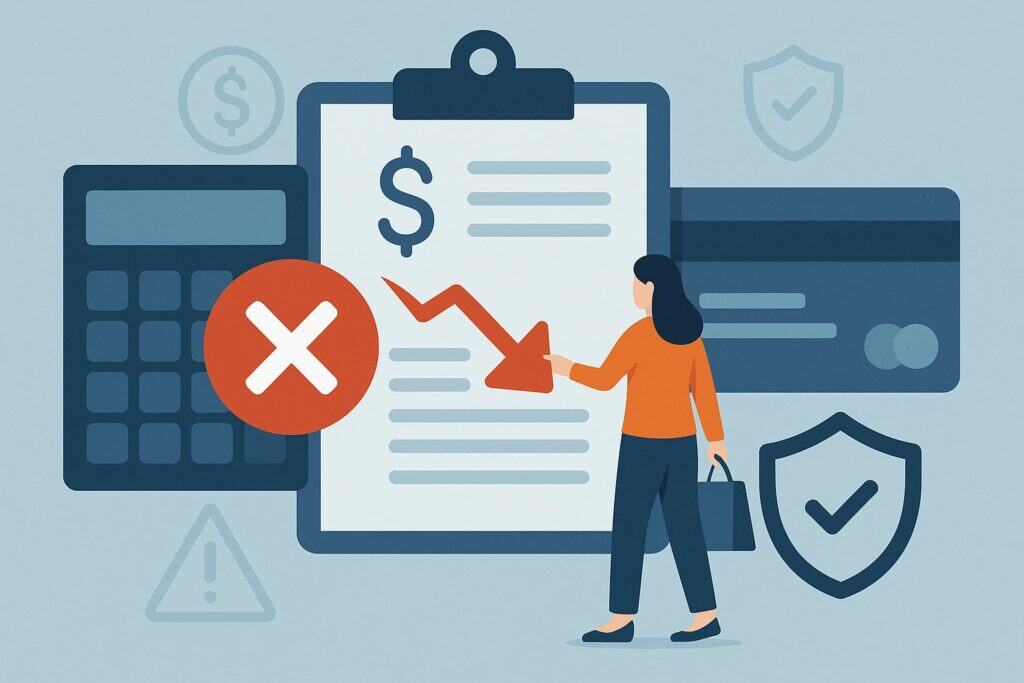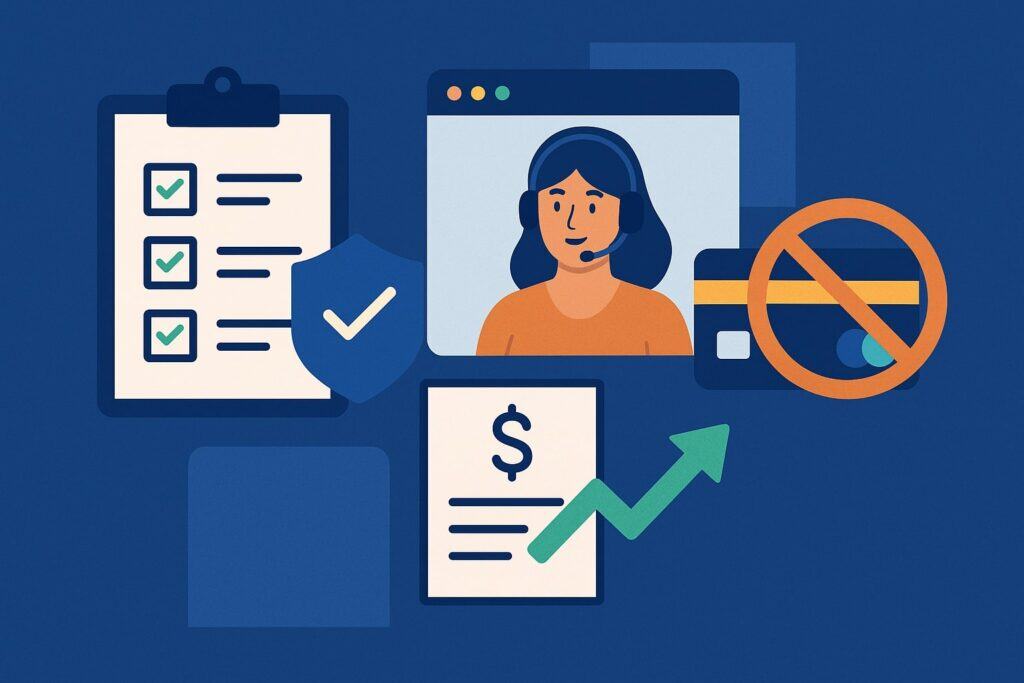
By pittsburgh-merchantservices October 17, 2025
Reducing chargebacks and avoiding extra fees is one of the most immediate ways U.S. businesses can protect margins, improve cash flow, and strengthen customer trust. Chargebacks don’t just reverse revenue; they often add chargeback fees, network penalties, and operational costs that quietly erode profitability.
This guide explains how to reduce chargebacks end-to-end—policy, payments, fulfillment, data, and disputes—so you can prevent problems before they start and successfully fight the ones that slip through.
You’ll learn how to use modern tools like EMV® 3-D Secure 2.x, apply the latest network rules on friendly fraud, meet PCI DSS v4.x requirements, and tune operations to keep authorization rates high and disputes low.
Throughout, we focus on practical, U.S.-specific best practices to reduce chargebacks and avoid extra fees while keeping your checkout experience smooth and compliant. When you operationalize these practices, you lower dispute ratios, reduce processor and network scrutiny, and create a flywheel of trust that lifts lifetime value.
The Real Cost of Chargebacks: Why Prevention Beats Recovery

Chargebacks hit hard in multiple ways. Beyond the lost sale, every dispute can trigger a chargeback fee from your processor, and a pattern of elevated ratios can escalate you into network monitoring programs that add monthly assessments or require corrective action.
Internal costs stack up too—staff time to gather evidence, customer service friction, replenishment of inventory, and shipping you can’t recover.
The reputational impact is real: banks may code your business as higher risk, which can weigh on authorization rates, and customers who resort to chargebacks are less likely to return. That’s why reducing chargebacks and avoiding extra fees is fundamentally about building systems that prevent disputes in the first place.
From a compliance angle, keeping chargebacks low is part of staying in good standing with card networks and your acquirer. Rules and timelines vary by network and reason code, but the direction is clear: data-rich, accurate, and transparent transactions are favored; unclear descriptors, poor communications, and subscription opacity create systemic risk.
As the U.S. payments landscape adds instant rails like FedNow, and e-commerce continues to dominate, merchants that align authorization, security, and customer experience reduce chargeback exposure while preserving conversion.
The investment you make in prevention—clear policies, verified orders, strong authentication, and consistent documentation—pays for itself by avoiding reversible revenue loss and the cascade of fees tied to disputes.
Policy & CX Foundations That Reduce Chargebacks Before They Start

Best-in-class chargeback prevention begins before the card is ever charged. Transparent, customer-centric policies set expectations and reduce the likelihood that a confused or frustrated buyer calls their bank.
Make your return, refund, and cancellation policies conspicuous on product pages and at checkout. Use plain language and remove gotchas. For subscriptions and free trials, provide a friction-free cancellation path. U.S. regulators have scrutinized “negative option” programs for years, and opaque cancellation flows are a major driver of disputes.
While the FTC’s proposed “Click-to-Cancel” rule targeting easy online cancellation was recently voided by a court, the consumer expectation it championed remains—simple, self-serve cancellation and clear consent reduce first-party disputes tied to subscriptions.
Next, align your customer support strategy to intercept problems early. Offer fast, visible support channels: responsive email, phone, and live chat during business hours. Proactively notify customers at key points—order confirmation, shipping with tracking, delivery confirmation, and subscription renewal notices.
When something goes wrong, empower agents to resolve issues quickly with replacements or partial refunds when appropriate. Your refund is almost always cheaper than a full chargeback (plus fees), and you control the narrative and learn from the root cause.
Use post-purchase surveys and return-reason coding to flag patterns that can be fixed upstream—sizing confusion, unclear product photos, or delayed shipping.
Finally, write your checkout and confirmation pages to eliminate ambiguity. Confirm the item, price, quantity, taxes, shipping, and any recurring billing cadence before the charge.
Present the descriptor that will appear on the card statement (or a recognizable brand name) and repeat it in the confirmation email. The more your descriptor matches what the customer expects, the fewer “what is this?” disputes.
For recurring billing, send advance renewal reminders with the exact date and amount and provide a one-click path to manage or cancel. These simple policy and UX moves are among the highest-ROI tactics to reduce chargebacks and avoid extra fees.
Payment & Authorization Tactics to Prevent Disputes (3-D Secure, CE3.0, and Reason Codes)

One of the most effective ways to reduce chargebacks is to improve the quality and verifiability of each authorization. On card-not-present (CNP) transactions, implement EMV® 3-D Secure (3DS) 2.x with device data, risk assessments, and frictionless flows where possible.
EMVCo continues to update the 3DS specifications (v2.3.x and bulletins) to strengthen authentication signals and optimize user experience. Properly deployed 3DS can shift fraud liability and reduce unauthorized use chargebacks without crushing conversion.
Vendors certified against current 3DS versions are listed by EMVCo, and keeping your stack current ensures you benefit from the latest risk and UX improvements.
Understand the current chargeback frameworks for each network, including reason codes, evidence windows, and response formats.
Mastercard’s current merchant chargeback guide (updated mid-2025) details the chargeback process, including when issuers may initiate a chargeback and how acquirers/merchants should respond.
Keeping your dispute playbooks aligned with the latest guide reduces procedural losses and avoids extra fees from missed deadlines or incomplete evidence.
For “friendly fraud” or first-party misuse (e.g., a customer claims they didn’t make the purchase when they did), Visa’s Compelling Evidence 3.0 (CE3.0) framework expanded the types of data that can remedy disputes—like prior undisputed transactions using the same device, IP, or account.
Merchants who capture and preserve these signals have a much better chance of short-circuiting illegitimate fraud claims at intake. Review Visa’s CE3.0 readiness materials with your acquirer and ensure your payment gateway or fraud tools can persist identity-level data tied to prior transactions.
Then, wire that data into your dispute responses so acquirers can trigger CE3.0 remedies when appropriate.
Lastly, tune AVS (Address Verification), CVV checks, velocity limits, and order-value thresholds. Pair these with adaptive risk scoring: step up to 3DS on higher-risk signals (new device, high ticket, mismatched AVS), and keep friction low for known good profiles.
This calibrated approach suppresses fraud-driven chargebacks while maintaining healthy approval rates and conversion.
Data Hygiene: Descriptors, Notifications, and Receipts That Head Off Disputes

Good data hygiene is an everyday superpower to reduce chargebacks and avoid extra fees. Start with your billing descriptor—the short line that appears on card statements. Make it meaningful: include your brand (or DBA), a city/state for context, and a phone or URL.
Mirror that same descriptor in order confirmations so the customer recognizes it later. If you operate multiple brands, avoid a generic corporate name that will confuse cardholders.
Automate transactional communications with clear, time-stamped receipts that summarize the product or service, price, taxes, discounts, fulfillment method, and support links. For shipped goods, include tracking numbers and expected delivery windows; for digital goods or services, note activation procedures, license keys, or service terms.
For subscriptions, add the renewal cadence, renewal date, and a simple path to manage the plan. Proactive reminders—like a 3–7 day heads-up before renewal or before a free trial converts—can significantly reduce “I forgot” disputes while demonstrating good faith.
Instrument your systems to capture and retain useful metadata: IP address, device fingerprint IDs (where privacy-compliant), login user ID, delivery confirmation, and support interactions.
These artifacts often serve as decisive evidence when a dispute occurs—especially under Visa CE3.0’s data-driven criteria for remedying first-party misuse claims.
Work with your gateway and acquirer to make sure these fields survive tokenization and are retrievable for dispute responses. The more consistent and accessible your documentation, the faster you can resolve issues without incurring additional network or processor fees.
Subscription & Free-Trial Risk Controls (Compliance Meets Conversion)
Recurring billing is a common source of chargebacks, often because customers can’t find how to cancel or misunderstand trial terms. Even though a federal court struck down the FTC’s “Click-to-Cancel” rule in July 2025, merchants should treat its spirit as a best practice: clear consent, prominent disclosures, and easy, online cancellation.
Why? Because ambiguity and friction invite cardholder disputes—and those disputes come with chargeback fees and potential network monitoring if ratios climb.
Align your flows with FTC guidance on payments and billing: obtain express consent, disclose trial length and renewal price plainly, and send renewal reminders with a self-serve cancellation path. These steps reduce first-party fraud and lower your dispute rate in a way customers appreciate.
Operationally, adopt dunning communications that warn customers before billing failures and after account changes. Offer pause or downgrade options so cancellations aren’t the only outlet for dissatisfaction.
In your CRM, tag subscriptions with lifecycle events—trial start, first renewal, plan changes—so support can quickly verify consent and timing during a complaint.
Store server logs that show in-account cancellations or plan edits with timestamps; these often defuse misunderstandings without needing to escalate to the bank. And when a refund is warranted, issue it promptly and confirm via email so the cardholder doesn’t proceed to a dispute.
Shipping, Delivery, and Fulfillment Proof That Wins Disputes
For physical goods, the easiest chargebacks to win—or avoid—are those where you can prove shipment, delivery, and successful handoff. Use carriers that provide tracking and delivery confirmation, and require signature on high-value orders.
Provide customers with tracking links immediately, and notify them upon delivery. If the shipment is split or delayed, communicate proactively; many “merchandise not received” disputes stem from avoidable confusion during backorders or preorders.
Address common fraud vectors with guardrails: block shipping to known freight forwarders on high-risk orders, require re-authentication or manual review for address changes post-order, and flag mismatches between billing and shipping addresses, especially for rush shipping.
Keep photographs of packed orders or serial numbers for luxury, electronics, or customized goods. If the customer claims a box was empty or swapped, serial-number capture combined with delivery scans and internal QA photos can be compelling evidence in your dispute package.
For services and digital goods, create service “delivery receipts.” These may be usage logs, login timestamps, download records, or session transcripts.
When you can show the buyer (or their device/account) accessed the service after purchase—particularly on multiple days—it becomes much harder for a first-party misuse claim to stick. These artifacts map cleanly to CE3.0 categories and can be the difference between a lost and remedied dispute.
Security & Compliance Essentials: PCI DSS v4.x, Tokenization, and Least-Friction Fraud Tools
Strong security controls are not just about breach prevention—they meaningfully reduce the fraud that drives chargebacks. U.S. merchants should align with PCI DSS v4.x, noting that new and revised requirements (v4.0.1) become fully effective as of March 31, 2025.
Even if you validate with SAQ A, updates to e-commerce requirements and guidance apply; the Council has issued clarifications and SAQ updates to help merchants comply.
Prioritize areas like web-skimming detection (11.6.1), change management for e-commerce (6.4.3), and governance (12.x), and work with your QSA or solution providers to confirm scope.
Meeting these requirements protects cardholder data, reduces fraud exposure, and helps keep you out of network monitoring programs that can add extra fees.
Pair compliance with pragmatic controls: tokenize cards to reduce storage risk, enable network tokenization to improve approval rates and lifecycle management, and deploy fraud tools that evaluate device signals, behavioral biometrics, and velocity patterns.
Calibrate your thresholds to your business model; an over-aggressive filter can cause false declines, leading customers to retry elsewhere and, occasionally, to file disputes out of frustration. Use A/B tests to balance conversion and risk, and revisit your rules as seasons and product mixes change.
Finally, keep authentication modern. EMV® 3DS 2.3.x supports richer data exchanges and better UX, including step-up only when necessary.
Work with a 3DS server and SDKs on EMVCo’s approved lists and verify that your provider supports the latest bulletins. Done right, 3DS lowers unauthorized use chargebacks without torpedoing checkout speed.
Dispute Response Playbooks That Leverage CE3.0 and Network Guides
Even with strong prevention, some disputes will land. To avoid extra fees and improve win rates, operationalize a disciplined dispute-response playbook. Start by mapping each common reason code to the evidence you’ll collect and the narrative you’ll present.
For fraud claims on repeat customers, assemble CE3.0-style data (prior undisputed transactions tied to the same device, IP, account, or address) so your acquirer can apply CE3.0 remedies where available.
Ensure your systems can retrieve this data quickly—dispute windows are short, and late or incomplete submissions increase costs.
For non-fraud disputes (not received, not as described, canceled recurring), build templates that include confirmations, tracking proofs, delivery scans, product pages, customer communications, refund policies, and any post-purchase usage.
Follow the latest Mastercard and Visa documentation for formatting, timelines, and submission standards; small formatting errors or missed fields add up to unnecessary losses.
Train a cross-functional team—support, operations, and finance—so no one scrambles when a case appears. The best programs measure dispute reasons monthly, find root causes, and assign owners to eliminate recurrent issues at the source.
Metrics & Thresholds: Staying Out of Network Monitoring and Fee Escalation
Card networks and acquirers monitor dispute ratios and fraud indicators. Persistently high levels can land you in monitoring programs that come with monthly assessments, stricter remediation, and, if unaddressed, the risk of termination.
While exact thresholds vary and evolve, your goal is to keep disputes and fraud comfortably below the lines that trigger enhanced scrutiny. Partner with your acquirer to understand your current standing and any early warnings.
Visa’s ecosystem-level monitoring emphasizes acquirer oversight; acquirers in turn look to merchants to implement robust controls and reduce risky practices that could compromise the network. Staying ahead of these thresholds is one of the most direct ways to avoid extra fees and maintain favorable processing terms.
Track a small, actionable KPI set: dispute rate (by count and by value), fraud rate (confirmed fraud), authorization rate, refund-to-chargeback ratio, and time-to-first-response. Segment by payment method, gateway, campaign, SKU, and geography to spot outliers quickly.
Then, run monthly reviews to close loops—if one SKU drives “not as described” disputes, adjust the product page and images; if one campaign drives a spike in fraud, refine targeting or add checkout friction for that cohort. This disciplined, data-driven approach prevents surprise escalations and the costly fees that follow.
Instant Payments, ACH, and the New Dispute Landscape
While card disputes dominate for many merchants, U.S. businesses increasingly accept ACH and instant payments. These rails have different authorization, fraud, and reversal rules—which means your prevention strategy must adapt.
The Federal Reserve’s FedNow® Service is a bank-to-bank instant rail with operating procedures distinct from card networks. Funds move in seconds and are generally irrevocable, so consumer “chargebacks” as known in the card world don’t translate directly.
Merchants should design flows that confirm identity and intent up front and present clear refund alternatives when issues arise.
Know your bank’s policies and the FedNow Operating Procedures that shape participant obligations so you can set accurate customer expectations and avoid disputes escalating into complaints or legal exposure.
For ACH, NACHA rules allow for certain returns (e.g., unauthorized debit) within defined windows. While not the same as card chargebacks, these can still create losses and bank fees.
Treat them with the same rigor: explicit consent, prenotifications when applicable, and easy cancellation paths for recurring debits. Provide alternate support remedies so customers don’t default to bank disputes.
The core principle remains: clear disclosures, robust authentication, and rapid, fair resolution reduce reversals and associated fees across all rails.
Team, Tools, and Playbooks: Building a Sustainable Chargeback Prevention Program
Lasting success comes from an internal program, not a one-time push. Assign ownership across three pillars: Prevention (CX, policy, fraud/authorization), Evidence (data capture and storage), and Response (dispute handling).
Document your workflows: who reviews orders, which thresholds trigger step-up authentication, and how evidence is assembled.
Integrate your gateway, fraud tool, CRM, and helpdesk so that one case record holds the entire transaction story—order details, logistics, customer messages, and device/3DS data. That single source of truth reduces handling time, improves accuracy, and increases your odds of winning.
Invest in training. Teach frontline staff how their actions affect dispute outcomes—how a well-worded email that reiterates policy and provides a refund can prevent a bank call, and how to escalate potential first-party misuse with the right tags.
Give your disputes team modern templates aligned to current network rules and CE3.0 criteria. Schedule quarterly reviews with your processor or acquirer to benchmark performance and get early warnings; these conversations often flag trends you can control before they evolve into fee-laden monitoring.
Finally, set a continuous-improvement cadence. Each month, pick one top driver (e.g., “canceled recurring” or “not received”), run a root-cause sprint, and ship fixes—new emails, updated images, stricter address checks, or better renewal notices.
Over time, this drumbeat will push your chargeback rate down and keep you clear of extra fees that drain profit.
FAQs
Q.1: What is a “good” chargeback rate, and why does it matter for fees?
Answer: A “good” rate is comfortably below network and acquirer alert levels (these thresholds vary by network and can change). Lower rates reduce your risk of being placed in monitoring programs that carry monthly assessments or other penalties.
Your acquirer can share your current ratios and any early-warning bands; tracking disputes weekly helps you stay ahead and avoid extra fees tied to elevated risk.
Q.2: Does EMV® 3-D Secure hurt conversion?
Answer: Implemented well, 3DS 2.x can improve authorization decisions and reduce unauthorized use chargebacks with minimal friction. Use risk-based authentication so only higher-risk transactions are stepped up.
Ensure your provider is current with EMVCo specifications and on the approved products list; newer versions and bulletins target better UX and broader device coverage.
Q.3: How do Visa’s CE3.0 updates help with friendly fraud?
Answer: CE3.0 lets acquirers remedy certain fraud disputes when merchants can supply specific, prior-transaction data linking the cardholder to the current purchase (e.g., same device, IP, account, or address from earlier, undisputed orders).
Set up your systems to capture and retrieve this evidence quickly. When criteria are met, illegitimate “I didn’t do it” claims are less likely to proceed, reducing chargebacks and fees.
Q.4: What about the FTC’s “Click-to-Cancel” rule—do I need to comply?
Answer: A federal court voided the FTC’s rule in July 2025. Regardless, merchants should adopt the same principles: make online cancellation easy, gain clear consent for negative options, and send renewal reminders.
These changes align with consumer expectations and measurably reduce subscription-related disputes and chargebacks that lead to fees.
Q.5: Which PCI DSS v4.x items are most relevant to reducing chargebacks?
Answer: While PCI DSS focuses on data security, meeting v4.x (including v4.0.1 clarifications effective March 31, 2025) reduces fraud that often triggers chargebacks.
For e-commerce, pay special attention to requirements around attack detection (11.6.1), secure software changes (6.4.3), and governance (12.x). The Council has issued updated guidance and SAQ A changes—review these with your QSA.
Q.6: Do instant payments like FedNow have chargebacks?
Answer: FedNow is an instant bank-to-bank rail with different rules than cards; payments are rapid and generally irrevocable. Preventive controls—strong authentication, clear consent, and fair refund policies—are critical.
Coordinate with your bank and review the FedNow Operating Procedures so customer expectations match what’s possible, reducing escalations and fees.
Conclusion
Reducing chargebacks and avoiding extra fees isn’t a mystery; it’s the outcome of a disciplined program that blends clear customer policies, modern authentication, tight data hygiene, and swift, evidence-rich responses.
Start with the basics: transparent returns, recognizable billing descriptors, friction-free subscription management, and responsive support that resolves issues before they become disputes.
Strengthen your payments stack with EMV® 3-D Secure 2.x and align your playbooks with Visa’s CE3.0 and current network dispute guides. Modernize security under PCI DSS v4.x so fraud has fewer openings. Then, measure relentlessly—by SKU, campaign, and channel—to find and fix root causes.
As you operationalize these steps, you’ll see chargeback rates fall, dispute wins rise, and costly add-on fees fade into the background. Even better, you’ll earn long-term customer trust. That combination—lower costs and higher loyalty—is the surest path to sustainable growth in the U.S. payments landscape.